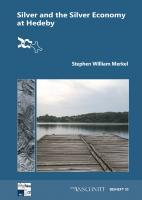Silver and the Silver Economy at Hedeby: Raw Materials, Innovation, Technology of Ancient Cultures - RITaK 2
Keywords:
coins, craftsmanship, dirhams, mining, silver, Vikings, settlement archaeologySynopsis
The trade of silver in Viking Age Scandinavia is intertwined with the development and collapse of long distance trade routes stretching as far as the North Atlantic in the West to Central Asia in the East. Hedeby, a Viking emporium, was an important gateway of trade between the Baltic and North Seas, and this makes it is an ideal place to explore the evolution of the silver supply in the 10th and 11th centuries A.D. The elemental and lead isotope compositions of locally minted Hedeby coins were compared to jewelry objects, hacksilver and imported silver coins, and four chronologically related shifts could be identified that reflect changes in the origin and type of raw materials used. This study features the use of laser ablation mass spectrometry of ca. 200 silver objects, and these analyses are placed in a broader context of early medieval silver metallurgy, mining archaeology and numismatics to interpret the compositional shifts as shifts in trade. Additionally, studies on crucibles and lead-based finds from Hedeby were carried out as well as the analysis of ore and slag from Central Asia to explore recycling and silver production technologies during the Viking period.





